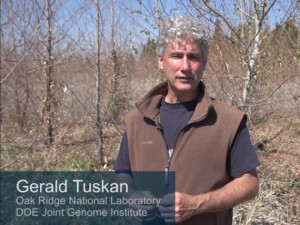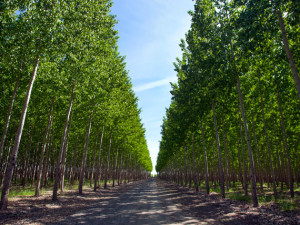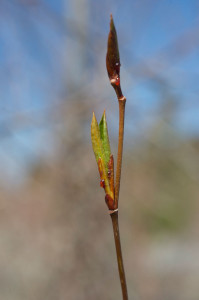Genome-Wide Study Shows Evidence of Genetic Selection

ORNL and DOE JGI researcher Jerry Tuskan talks about the poplar plantations and the importance of understanding selection at http://bit.ly/Tuskan14fingerprints.
One aspect of the climate change models researchers have been developing looks at how plant ranges might shift, and how factors such as temperature, water availability, and light levels might come into play. Forests creeping steadily north and becoming established in the thawing Arctic is just one of the predicted effects of rising global temperatures.
A recent study published online August 24, 2014 in Nature Genetics offers a more in-depth, population-based approach to identifying such mechanisms for adaptation, and describes a method that could be harnessed for developing more accurate predictive climate change models. For the U.S. Department of Energy, which is developing biomass crops for biofuels production, this knowledge could determine which genotypes – genetic makeup of an organism – of biomass crop may thrive better than others in certain environments. The team led by Gerald Tuskan of Oak Ridge National Laboratory (ORNL), the Department of Energy Joint Genome Institute (DOE JGI) – a DOE Office of Science user facility – and Stephen DiFazio of West Virginia University, used a combination of genome-wide selection scans and analyses to understand the processes involved in shaping the genetic variation of natural poplar (Populus trichocarpa) populations.

Hybrid poplar trees growing in Greenwood Resources plantations near Boardman, OR. These trees have the highest annual productivity of any hardwood species in North America. The research described here is aimed at developing molecular markers to customize poplar for bioenergy production. (DOE JGI)
As part of this long-term study, the team took samples from 1,100 poplar trees growing in wild populations in California, Oregon, Washington and British Columbia. They then clonally propagated (through cuttings) these trees in three plantations in California and Oregon. For their analyses, they pared the group down to 544 unrelated individuals whose genotypes could be accurately determined so as to characterize the genetic basis for variation in adaptation. The shift from an approach focused on single candidate genes to the large-scale computational approach analyzing all of them is made possible by the availability of the poplar genome, which was published in the journal Science in 2006 by the DOE JGI. Since the genome was made publicly available, it has been used to understand woody perennial plant development and served as a model for genome-level insights in forest trees. The publication itself has been cited more than 1,000 times in a wide variety of journals.
“This is the first time that deep genomics resources have ever been applied to an ecological question, in this case: ‘What does selection do at the genome level?’” said Tuskan. “In the past, people looked at adaptation to factors such as temperature and light levels, and they examined variation in those genes as they vary across environmental gradients. There was a preconceived notion and a very narrow view of what was causing the response. Here, we took five major approaches, applied them blindly to the whole genome, and let the analysis show us where the fingerprints of selection are and what genes fall under those fingerprints.” Watch a video of Tuskan on the importance of selection in trees at http://bit.ly/Tuskan14fingerprints.

Close-up of a poplar leaf bud. The team identified hundreds of genomic regions that contribute to adaptive traits for wild populations of poplars. such as how regional temperatures can affect the timing of spring bud flush and fall bud set. (DOE JGI)
Going from 1,000 genotypes and 45,000 genes “to figuring out what’s not just statistically significant but biologically meaningful” wasn’t easy, said study first author Luke Evans of West Virginia University. “We did it by determining selection targets – things that looked like they might be under natural selection in wild populations and looked at growth and performance evidence that they affect adaptive traits. If these targets showed not only computational evidence of selection but also influenced phenotypes, it was a nice sort of dovetailing that was mutually supportive.”
DiFazio highlighted the significance of the computational work. “Our approach is particularly powerful because we are mining standing natural variation resulting from tens of thousands of years of evolution and selection such that the alleles or gene variants that we have identified have great promise to provide robust, long-term improvements to biofuel feedstocks.”
Evans also noted that their study yielded nearly 18 million single base pair variants of DNA sequence (called “SNPs”) in poplar. These data can be accessed at Phytozome, DOE JGI’s plant comparative genomics portal (phytozome.jgi.doe.gov). “That’s a massive number of naturally occurring variants, a lot in cell wall chemistry genes and other known productivity genes. This provides an immediate resource for tree breeding programs,” he said.
The team identified 397 genomic regions that contribute to adaptive traits for wild populations of poplars. For example, data gathered on height, spring bud flush and fall bud set from the clonally-replicated poplars growing in three plantations indicated that in warmer climates, trees with earlier bud flush and later bud set were favored.

ORNL’s David Weston processing samples collected from the Populus trichocarpa plantation growing in Clatskanie, Oregon. The researchers are identifying molecular mechanisms underlying a wide variety of traits related to tree growth and adaptation using whole genome sequences for the entire clonally-replicated population. Pictured here are leaf epidermal peels which reveal stomatal density. (Images by Wendy Schackwitz, DOE JGI). At the top right is an image of the stomata. (Image courtesy of DiFazio Lab.)
Given the importance of poplar trees, not just for their role in the ecosystem, for instance, in capturing carbon, but also for their economic importance in fields ranging from timber to bioenergy, Evans noted that the ability to have plantations of poplars through vegetative propagation is a significant tree-breeding tool for picking the appropriate stocks for the task. “If you know every base in a genome, you can skip whole generations and use genomic information to predict how well an individual will do,” he said. “Plantations serve as the initial tests where you can take that genomic information and calibrate those predictions. With those reference points, you can scale everything.”
Aside from Evans, Tuskan, and DiFazio, other authors on the study were Gancho Slavov of Aberystwyth University, UK; Eli Rodgers-Melnick of West Virginia University, Joel Martin and Wendy Schackwitz of the DOE JGI; Priya Ranjan, Wellington Muchero, Lee Gunter, Jin-Gui Chen of ORNL; and Amy Brunner of Virginia Tech. Jerry Tuskan spoke about the poplar project at the 2014 Genomics of Energy & Environment Meeting – watch his talk. Wellington Muchero spoke about studying poplar in relation to cell wall formation at the 2012 Genomics of Energy & Environment Meeting – watch his talk.
Members of the BioEnergy Science Center (BESC), a U.S. DOE Bioenergy Research Center supported by the Office of Biological and Environmental Research in the DOE Office of Science, contributed to the published work, in particular the collection, propagation, and maintenance of the common gardens.